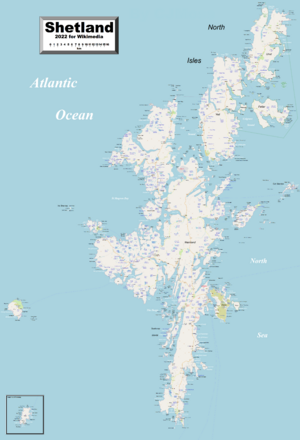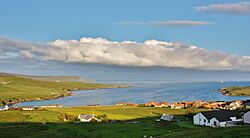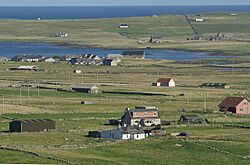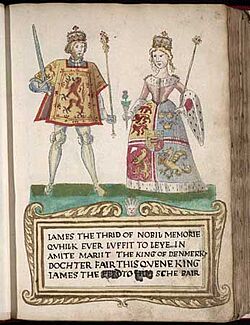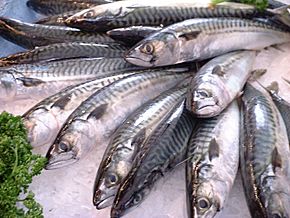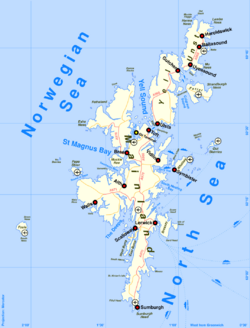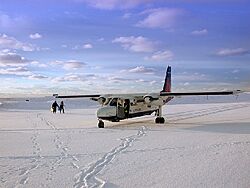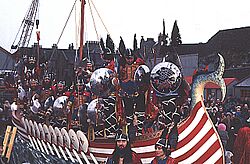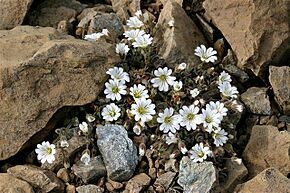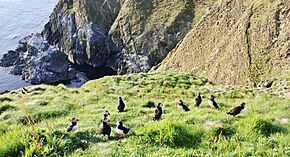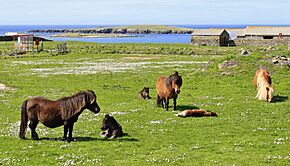Shetland facts for kids
| Gaelic name | Sealtainn |
|---|---|
| Norse name | Hjaltland |
| Meaning of name | 'Hiltland' |
| OS grid reference | HU4363 |
| Coordinates | 60°20′N 1°20′W / 60.333°N 1.333°W |
| Physical geography | |
| Island group | Northern Isles |
| Area | 1,466 km2 (566 sq mi) |
| Highest elevation | Ronas Hill 450 m (1,480 ft) |
| Administration | |
| Sovereign state | United Kingdom |
| Country | Scotland |
| Council area | Shetland Islands Council |
| Demographics | |
| Population | 22,920 (2019) |
| Population density | 15/km2 (39/sq mi) |
| Largest settlement | Lerwick |
Shetland, also known as the Shetland Islands, is a group of islands in Scotland. It lies between Orkney, the Faroe Islands, and Norway. Shetland is the most northern part of the United Kingdom.
These islands are about 80 kilometers (50 miles) northeast of Orkney. They are 170 kilometers (106 miles) from mainland Scotland and 220 kilometers (137 miles) west of Norway. Shetland sits on the edge of the Atlantic Ocean to the west and the North Sea to the east. The total area is 1,466 square kilometers (566 square miles). In 2019, about 22,920 people lived there.
The Shetland Islands Council manages the islands. Lerwick is the main town and capital of Shetland. It has been the capital since 1708, taking over from Scalloway.
Shetland has an oceanic climate, which means mild, wet weather. It has interesting geology, a rugged coastline, and many low, rolling hills. The largest island is called "the Mainland". It covers 967 square kilometers (373 square miles). This makes it the fifth-largest island in the British Isles. Shetland has 16 islands where people live.
People have lived in Shetland since the Mesolithic period (Middle Stone Age). The Picts were the first known people to live here. Later, the Norse people from Norway took over and settled the islands. From the 900s to the 1400s, Shetland was part of the Kingdom of Norway. It then became part of the Kingdom of Scotland because of a royal agreement.
When Scotland and England joined to form the Kingdom of Great Britain in 1707, trade with northern Europe slowed down. In the 1970s, North Sea oil was discovered. This greatly helped Shetland's economy, creating jobs and income. Fishing has always been a very important part of the islands' economy.
Life in Shetland still shows its Norse roots. This includes the Up Helly Aa fire festivals and a strong tradition of music, especially fiddle playing. Most place names on the islands come from Norse words. Many writers and poets from Shetland often write in the special Shetland dialect of the Scots language.
Many areas are protected to help local fauna (animals) and flora (plants). These include important places where seabirds nest. The Shetland pony and Shetland Sheepdog are two famous animal breeds from Shetland. Other local breeds include the Shetland sheep, cow, goose, and duck. The Shetland pig, or grice, died out around 1930.
The islands' motto is "Með lögum skal land byggja". This means "By law shall the land be built". It comes from Old Norse and shows the islands' strong connection to their past.
Contents
- What's in a Name?
- Exploring Shetland's Land and Rocks
- Shetland's Towns and Villages
- Shetland's Ancient Past
- Shetland's History
- Shetland's Economy
- Getting Around Shetland
- Learning in Shetland
- Sports in Shetland
- Churches and Beliefs
- Shetland's Flag
- Culture and Arts in Shetland
- Wildlife in Shetland
- Images for kids
- See also
What's in a Name?
The name Shetland might come from the Old Norse words hjalt (meaning 'hilt') and land ('land'). Another idea is that the first part of the name comes from an ancient Celtic tribe.
Long ago, Roman writers mentioned islands that scholars believe were Shetland. For example, in 43 CE, Pomponius Mela called them the Haemodae. Later, in 77 CE, Pliny the Elder called them the Acmodae.
In old Irish writings, Shetland was called Insi Catt. This means "the Isles of Cats". This might have been the name used by the people living there before the Norse arrived. The "Cat" tribe also lived in parts of northern Scotland. Their name is still seen in places like Caithness.
The oldest known version of the modern name is Hetland. This could mean "Catland", with the 'C' sound changing to 'H' in Germanic languages. Over time, the name changed through different forms. The Norse language spoken in Shetland, called Norn, was slowly replaced by the Shetland dialect of Scots. The old Norse name Hjaltland became Ȝetland. The letter 'Ȝ' (yogh) was later replaced by 'Z', which is why the islands were sometimes called Zetland. This is also why the postcode for Shetland starts with ZE.
Most of the individual islands in Shetland have Norse names. However, the meanings of some are not clear. They might come from even older languages spoken before the Norse or Celtic people.
Exploring Shetland's Land and Rocks

Shetland is about 170 kilometers (106 miles) north of Great Britain. It is also about 230 kilometers (143 miles) west of Bergen, Norway. The islands cover an area of 1,468 square kilometers (567 square miles). Their coastline is very long, stretching 2,702 kilometers (1,679 miles).
Lerwick is the capital and largest town. It has a population of 6,958 people. About half of Shetland's total population of 22,920 live within 16 kilometers (10 miles) of Lerwick. Scalloway, on the west coast, was the capital until 1708. It has fewer than 1,000 people.
Only 16 of Shetland's roughly 100 islands are inhabited. The main island is called Mainland. Other large islands to the north are Yell, Unst, and Fetlar. To the east are Bressay and Whalsay. Smaller islands to the west include East and West Burra, Muckle Roe, Papa Stour, Trondra, and Vaila.
Other inhabited islands are Foula, 28 kilometers (17 miles) west of Walls. Fair Isle is 38 kilometers (24 miles) southwest of Sumburgh Head. The Out Skerries are to the east.
Uninhabited islands include Mousa, famous for the Broch of Mousa. This is a very well-preserved Iron Age tower. Noss is a national nature reserve. St Ninian's Isle is connected to Mainland by a sandy causeway called a tombolo. Out Stack is the most northern point of the British Isles. Shetland's location means it holds many such records. For example, Muness is the most northerly castle in the UK. Skaw is the most northerly settlement.
Shetland's geology is complex, with many faults and folds. These islands are the northern part of the Caledonian orogeny, a mountain-building event. They have rocks similar to those on the Scottish mainland. A special feature is the ophiolite in Unst and Fetlar. This is a piece of ancient Iapetus Ocean floor.
Much of Shetland's economy relies on the oil found in the surrounding seas. Scientists believe that around 6100 BC, a tsunami hit Shetland. This was caused by the Storegga Slide. The wave might have been up to 25 meters (82 feet) high in the narrow inlets called voes.
The highest point in Shetland is Ronas Hill at 450 meters (1,476 feet). During the Ice Ages, glaciers covered the islands. They left behind large rocks, like the 2000-tonne glacial erratic called Stanes of Stofast.
Shetland has many sea stacks, which are tall rock columns in the sea. About 110 of Scotland's 275 sea stacks are found around Shetland.
Shetland has a special national scenic area. This includes places like Fair Isle, Foula, and Esha Ness. This designation helps protect the beautiful landscapes.
In 2018, a law was passed in Scotland. It stops maps from showing Shetland in a separate box. This ensures the islands' true distance from other areas is clear.
Shetland's Weather
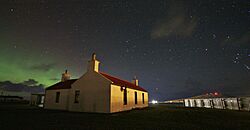
Shetland has a mild, oceanic climate. Winters are long but cool, and summers are short and mild. The sea keeps temperatures moderate all year. Average low temperatures in January and February are just above 1°C (34°F). Average high temperatures in July and August are around 14°C (57°F). The highest temperature ever recorded was 27.8°C (82.0°F) in 1910. The lowest was -8.9°C (16.0°F) in 1952 and 1959.
The weather is often windy and cloudy. Rain falls on more than 250 days a year. The average yearly rainfall is 1,003 millimeters (39.5 inches). November and December are the wettest months. Snow usually falls from November to February but rarely stays on the ground for long. Fog is common in summer because the cool sea air meets warmer air.
Because Shetland is so far north, you can sometimes see the northern lights on clear winter nights. In summer, there is almost constant daylight. This is known locally as the "simmer dim". Shetland gets about 1,110 hours of sunshine each year.
| Climate data for Shetland Isles (S. Screen) , elevation 82 m (269 ft), 1991–2020 normals, extremes 1930–present | |||||||||||||
|---|---|---|---|---|---|---|---|---|---|---|---|---|---|
| Month | Jan | Feb | Mar | Apr | May | Jun | Jul | Aug | Sep | Oct | Nov | Dec | Year |
| Record high °C (°F) | 12.8 (55.0) |
11.7 (53.1) |
13.3 (55.9) |
16.1 (61.0) |
20.7 (69.3) |
22.2 (72.0) |
23.4 (74.1) |
22.1 (71.8) |
19.4 (66.9) |
17.2 (63.0) |
13.9 (57.0) |
12.6 (54.7) |
23.4 (74.1) |
| Mean daily maximum °C (°F) | 6.1 (43.0) |
5.8 (42.4) |
6.7 (44.1) |
8.3 (46.9) |
10.6 (51.1) |
12.6 (54.7) |
14.4 (57.9) |
14.7 (58.5) |
13.0 (55.4) |
10.4 (50.7) |
8.1 (46.6) |
6.6 (43.9) |
9.8 (49.6) |
| Daily mean °C (°F) | 4.1 (39.4) |
3.8 (38.8) |
4.6 (40.3) |
6.1 (43.0) |
8.1 (46.6) |
10.3 (50.5) |
12.2 (54.0) |
12.6 (54.7) |
11.1 (52.0) |
8.5 (47.3) |
6.2 (43.2) |
4.5 (40.1) |
7.7 (45.9) |
| Mean daily minimum °C (°F) | 2.2 (36.0) |
1.8 (35.2) |
2.4 (36.3) |
3.8 (38.8) |
5.6 (42.1) |
8.1 (46.6) |
10.1 (50.2) |
10.5 (50.9) |
9.1 (48.4) |
6.6 (43.9) |
4.3 (39.7) |
2.5 (36.5) |
5.3 (41.5) |
| Record low °C (°F) | −8.9 (16.0) |
−7.4 (18.7) |
−8.3 (17.1) |
−5.7 (21.7) |
−2.2 (28.0) |
−0.6 (30.9) |
3.5 (38.3) |
2.8 (37.0) |
−0.6 (30.9) |
−3.3 (26.1) |
−5.7 (21.7) |
−8.2 (17.2) |
−8.9 (16.0) |
| Average precipitation mm (inches) | 150.4 (5.92) |
122.7 (4.83) |
109.2 (4.30) |
67.8 (2.67) |
56.9 (2.24) |
59.8 (2.35) |
67.7 (2.67) |
88.6 (3.49) |
105.8 (4.17) |
130.6 (5.14) |
143.2 (5.64) |
149.7 (5.89) |
1,252.3 (49.30) |
| Average precipitation days (≥ 1.0 mm) | 22.0 | 19.2 | 19.3 | 14.7 | 11.7 | 11.5 | 12.1 | 13.1 | 16.1 | 20.3 | 21.5 | 22.6 | 204.1 |
| Average snowy days | 10 | 9 | 9 | 5 | 1 | 0 | 0 | 0 | 0 | 1 | 5 | 8 | 48 |
| Average relative humidity (%) | 87 | 86 | 86 | 87 | 88 | 89 | 90 | 91 | 90 | 89 | 87 | 87 | 89 |
| Mean monthly sunshine hours | 27.4 | 57.6 | 97.7 | 141.2 | 191.9 | 147.7 | 128.6 | 132.4 | 99.5 | 75.1 | 38.3 | 20.6 | 1,158 |
| Source 1: Met Office NOAA (relative humidity and snow days 1961–1990) | |||||||||||||
| Source 2: KNMI | |||||||||||||
Shetland's Towns and Villages
Here are some of the main towns and villages in Shetland:
| Settlement | Population (2020) |
|---|---|
| Lerwick | 6760 |
| Scalloway | 1170 |
| Brae | 750 |
| Sandwick | <500 |
| Aith | <500 |
| Mid Yell | <500 |
| Baltasound | <500 |
| Symbister | <500 |
Here is a list of Shetland's islands by their population:
| Island | Population | ||
|---|---|---|---|
| 1991 | 2001 | 2011 | |
| Shetland Mainland | 17,562 | 17,550 | 18,765 |
| Whalsay | 1,041 | 1,034 | 1,061 |
| Yell | 1,075 | 957 | 966 |
| West Burra | 817 | 753 | 776 |
| Unst | 1,055 | 720 | 632 |
| Bressay | 352 | 384 | 368 |
| Trondra | 117 | 133 | 135 |
| Muckle Roe | 115 | 104 | 130 |
| East Burra | 72 | 66 | 76 |
| Fair Isle | 67 | 69 | 68 |
Shetland's Ancient Past

Shetland has many ancient sites because people built with stone on the islands, which had few trees. There are over 5,000 archaeological sites. The oldest signs of human life date back to 4320–4030 BC. This was during the Mesolithic period (Middle Stone Age). Tools made from local stone, called "Shetland knives", also come from this time.
The important site of Jarlshof shows signs of people living there since the Stone Age. It includes a smithy, round stone houses called wheelhouses, and a later tower called a broch. People lived at Jarlshof through many periods, right up to Viking times.
During the Iron Age, many brochs were built. Besides Mousa, there are important ruins at Clickimin and Old Scatness. The people living in the Northern Isles during the later Iron Age were likely Picts. In 2011, the sites of Mousa, Old Scatness, and Jarlshof were added to the UK's list for World Heritage Sites.
Shetland's History
Viking Settlers in Shetland
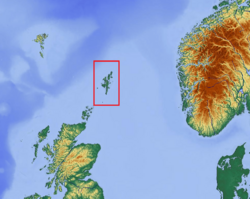
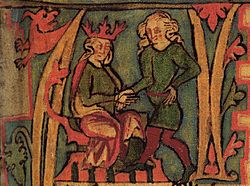
As the population in Scandinavia grew, people needed more land. This led to the Viking expansion. The Norse people started to invade instead of just raiding. Shetland was settled by Vikings in the late 700s and 800s. We don't know for sure what happened to the Pictish people who lived there already. Many modern Shetlanders still have Norse DNA.
The Vikings used the islands as a base for raids on Norway and Scotland. In response, Norwegian King Harald Fair Hair took control of the Northern Isles (Orkney and Shetland) in 875. He gave Orkney and Shetland as an earldom to Rognvald Eysteinsson.
The islands became Christian in the late 900s. King Olaf I of Norway ordered the local leader, Sigurd the Stout, to be baptized. Sigurd agreed, and the islands quickly became Christian. For a long time, the Norse leaders of Shetland also had ties to the Scottish crown.
In 1194, a rebellion against King Sverre Sigurdsson of Norway happened. After winning, King Sverre put Shetland directly under Norwegian rule. This lasted for almost 200 years.
Shetland Joins Scotland
From the mid-1200s, Scottish kings wanted to control the islands around their country. This led to an invasion of Scotland by King Haakon IV of Norway. His fleet gathered in Bressay Sound before sailing to Scotland. After a difficult battle, Haakon went back to Orkney and died there in 1263. His death stopped Norway's expansion in Scotland. The Hebrides and Mann islands were given to Scotland in 1266. However, Orkney and Shetland remained Norwegian.
In the 1300s, Orkney and Shetland were still Norwegian, but Scotland's influence grew. In 1469, Christian I, King of Norway, offered Shetland as a guarantee for his daughter Margaret's dowry. Margaret was marrying James III of Scotland. The money was never paid, so Shetland became permanently connected to the Scottish Crown. This was confirmed by the Parliament of Scotland in 1472.
From the early 1400s, Shetlanders traded with German merchants from the Hanseatic League. They sold fish, wool, and butter, and bought salt, cloth, and beer. In the late 1500s and early 1600s, Robert Stewart and his son Patrick controlled the islands. Patrick started building Scalloway Castle.
Later Centuries and Changes
When Scotland and England united in 1707, trade with Germany stopped. This caused economic problems for Shetland. Local merchants then started their own trade. This meant that independent farmers had to fish for these merchants.
Diseases like Smallpox affected the islands in the 1600s and 1700s. But after 1800, vaccines improved health. The islands were hit hard by a potato famine in 1846. The government sent help, and roads were improved.
The population grew to 31,670 in 1861. However, many Shetlanders faced hardship. The Royal Navy often forced men to join the navy. Between 1861 and 1881, over 8,000 Shetlanders moved away. A law in 1886 helped farmers own their small farms. Later, the herring fishing industry boomed from 1880 until the 1920s.
The Local Government (Scotland) Act 1889 created local councils. The Zetland County Council was set up in Lerwick in 1890.
Shetland in the 20th Century
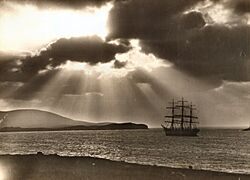
During World War I, many Shetlanders served in the military and merchant navy. Over 500 men from Shetland died, a higher percentage than in most other parts of Britain. More people left the islands in the 1920s and 1930s.
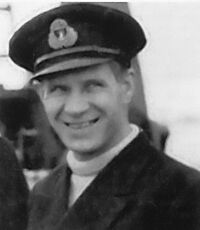
In World War II, a Norwegian naval unit called the "Shetland Bus" was formed. It helped carry agents, refugees, and supplies to Norway. It made over 200 trips. Leif Larsen, a famous Norwegian officer, made 52 of these trips.
In the late 1900s, oil was found in the seas around Shetland. This brought new income to the islands. The East Shetland Basin is a major oil area. Money from oil has helped fund public services and local programs. Some people briefly wanted Shetland to have more self-rule, like the Isle of Man or the Faroe Islands.
The population was 17,814 in 1961.
Shetland's Economy
Today, Shetland's main sources of income are agriculture, aquaculture (fish farming), fishing, renewable energy, the oil and gas industry, creative industries, and tourism. Unst also has a rocket launch site called SaxaVord Spaceport. Companies plan to launch rockets from there in the future.
Shetland relies less on tourism than some other Scottish islands. Oil is still important, but the islands are moving towards clean renewable energy. Fishing remains a very important industry and is expected to grow.
Fishing in Shetland
Fishing is very important to Shetland's economy. In 2009, the total catch was 75,767 tonnes, worth over £73.2 million. Atlantic mackerel makes up more than half of the catch. Other important fish include haddock, cod, herring, and shellfish.
New fish markets in Lerwick and Scalloway are helping the industry grow. Shetland lands more fish than England, Wales, and Northern Ireland combined. Shetland also produces 40,000 tonnes of salmon each year, worth £180 million. It grows 6,500 tonnes of mussels, which is over 80% of Scotland's total production.
Energy and Oil in Shetland
Oil and gas first arrived in Shetland in 1978 at Sullom Voe. This has become one of Europe's largest oil terminals. Money from oil has helped pay for social welfare, arts, sports, and environmental projects. Most of Shetland's workers are in the service sector. The Shetland Islands Council itself employs many people. Oil money also funds the Shetland Charitable Trust, which supports many local programs.
In 2007, the Shetland Islands Council agreed to build the Viking Wind Farm. This project will have 200 wind turbines and produce about 600 megawatts of power. It is expected to bring £20 million to Shetland's economy each year. Some people on the islands are against the plan because of how it will look. The PURE project in Unst uses wind power and fuel cells to create a wind hydrogen system.
Shetland is also working on using hydrogen as a future energy source. The ORION project aims to create an energy hub that uses clean electricity to make "blue and green hydrogen". The Scottish government supports these plans with investments.
Farming and Textiles
Farming in Shetland mainly involves raising Shetland sheep. These sheep are known for their very fine wool.
Knitwear is important to Shetland's economy and culture. The Fair Isle design is famous. However, the industry faces challenges from other companies using the "Shetland" name unfairly. A special trademark, "The Shetland Lady", helps protect local products.
Crofting is a traditional way of farming small plots of land. It is still practiced and is a key part of Shetland's heritage and income. Farmers grow oats and barley, but the cold, windy islands make it hard for most plants to grow.
Media in Shetland
Television signals in Shetland come from the Bressay TV transmitter. Shetland has a weekly local newspaper, The Shetland Times, and an online news service called Shetland News. Radio services are provided by BBC Radio Shetland and SIBC.
Tourism in Shetland
Shetland is a popular place for cruise ships. In 2010, the Lonely Planet guide called Shetland one of the best places in the world for tourists. They described the islands as "beautiful and rewarding" and the people as "fiercely independent". In 2006, visitors spent £16.4 million. In 2019, over 107,000 cruise ship passengers visited Lerwick Harbour.
The most popular attractions in 2009 included the Shetland Museum, the RSPB reserve at Sumburgh Head, and Jarlshof. Geopark Shetland (now Shetland UNESCO Global Geopark) was created in 2009 to help tourism.
Tourism increased by £12.6 million between 2017 and 2019. More than half of visitors gave their trip a perfect rating.
The BBC One TV series Shetland (TV series) is a crime drama set in the islands. It is based on books by Ann Cleeves. The show has made many people want to visit Shetland. Tourists from all over the world come to see the places where the series is filmed.
In 2018, 91,000 cruise ship passengers visited, a record high. This number dropped to over 76,000 in 2019.
How COVID-19 Affected Tourism
Tourism dropped a lot in 2020 and 2021 because of the COVID-19 pandemic. Travel restrictions meant fewer cruise ships and visitors.
In early 2021, the Promote Shetland website advised against non-essential travel to Shetland. The Scottish government also recommended avoiding unnecessary travel between Scotland and other parts of the UK.
A report in September 2020 said that the Highlands and Islands region was hit hard by the pandemic. The tourism industry needed financial help to survive. Ferries and buses were restricted to essential travel. The Scottish government introduced schemes to help businesses affected by restrictions.
Getting Around Shetland
Travel between Shetland's islands is mainly by ferry. The Shetland Islands Council runs many inter-island services. Shetland also has a ferry service from Lerwick to Aberdeen in mainland Scotland. This trip takes about 12 hours and is run by NorthLink Ferries. Some ferries also stop at Kirkwall, Orkney. There are plans for road tunnels to some islands, like Bressay and Whalsay.
Sumburgh Airport is Shetland's main airport. It is about 40 kilometers (25 miles) south of Lerwick. Loganair flies from Sumburgh to other parts of Scotland, including Kirkwall, Aberdeen, Inverness, Glasgow, and Edinburgh. Lerwick/Tingwall Airport is 11 kilometers (7 miles) west of Lerwick. It handles flights between the Shetland Mainland and Fair Isle and Foula.
Scatsta Airport near Sullom Voe used to have frequent flights for oilfield workers. It closed on June 30, 2020.
Public bus services run on Mainland, Trondra, Burra, Unst, and Yell. There are also special "dial-a-ride" services in Bressay and Fetlar. Buses connect with ferries to Foula, Papa Stour, and Whalsay.
Shetland's coasts are exposed to strong winds and tides. Many ships have been wrecked there. Lighthouses help guide ships safely.
Learning in Shetland
In early 2021, Shetland had 22 primary schools, five junior high schools, and two high schools: Anderson High School and Brae High School.
Shetland College UHI is part of the University of the Highlands and Islands (UHI). UHI's Centre for Rural Creativity works with Shetland Arts Development Agency. They offer courses in film, music, and media. The North Atlantic Fisheries College (NAFC) also works with UHI. It provides training for jobs in the sea industries.
The Institute for Northern Studies, run by UHI, offers advanced study programs. One of its locations is in Shetland.
Sports in Shetland
The Shetland Football Association manages two football leagues: a Premier League and a Reserve League. These are linked with the Scottish Amateur Football Association. Football seasons take place in the summer.
Shetland also has its own Shetland football team. This team often competes in the Island Games, a multi-sport event for islands.
Churches and Beliefs
Religion in Shetland (2011) Non-religious (45.4%) Church of Scotland (29.9%) Catholic Church (4.1%) Other Christian (10.6%) Islam (0.4%) Other religions (1.1%) Not stated (8.5%)
The Reformation reached Shetland in 1560. This change was peaceful, and there is little history of religious conflict in Shetland.
In the 2011 census, Shetland had more people with no religion than the average for Scotland. However, many different religious groups are present on the islands.
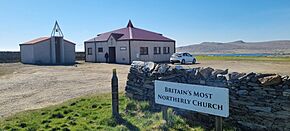
The Methodist Church has many members in Shetland. It is a special District of the Methodist Church.
The Church of Scotland used to have its own Presbytery (a church district) for Shetland. This included St. Columba's Church in Lerwick. In 2020, the Shetland Presbytery joined with Aberdeen's. Now, all Church of Scotland parishes in Shetland have merged into one.
The Catholic community attends St. Margaret and the Sacred Heart church in Lerwick. This parish is part of the Diocese of Aberdeen.
The Scottish Episcopal Church (part of the Anglican Communion) holds regular services. These are at St Magnus' Church in Lerwick, St Colman's Church in Burravoe, and the Chapel of Christ the Encompasser in Fetlar.
The Church of Jesus Christ of Latter-day Saints has a group in Lerwick. Their chapel used to be the local newspaper's printing office. Jehovah's Witnesses also have a group and Kingdom Hall in Lerwick.
Shetland's Flag
Roy Grönneberg designed the flag of Shetland with Bill Adams. He founded the local Scottish National Party in 1966. They created the flag to celebrate 500 years since the islands moved from Norway to Scotland. The flag uses the same colors as the flag of Scotland. However, it has the shape of a Nordic cross, like the flags of Scandinavian countries. After several tries, the Lord Lyon King of Arms approved it as Shetland's official flag in 2005.
Culture and Arts in Shetland
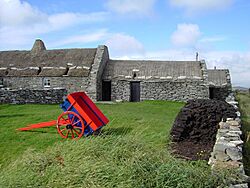
After Shetland officially became part of Scotland in 1472, some Scottish families moved there. However, studies show that a large part of Shetland's population still has Scandinavian roots. This mix of cultures is seen in many parts of local life. For example, almost all place names come from Viking words.
The Lerwick Up Helly Aa is a famous fire festival held every winter. It starts on the last Tuesday of January. The festival is over 100 years old in its current form. It began to break up the long winter nights and mark the end of Yule. Now, it celebrates the islands' heritage. It includes a parade of men dressed as Vikings and the burning of a replica longship.
Shetland also takes part in the International Island Games every two years. Shetland hosted the games in 2005.
Shetland's cuisine uses local lamb, beef, and seafood. Some of it is organic. The Valhalla Brewery makes real ale and is the most northern brewery in Britain. The Shetland Black is a special type of blue potato with dark skin and indigo-colored flesh.
Language in Shetland
The Norn language was a form of Old Norse spoken in the Northern Isles. It was spoken until the 1700s. It was slowly replaced by a local version of Scots, called Shetlandic. Now, Scottish English is also becoming more common. Even though Norn is no longer spoken, its influence remains in the Insular Scots dialects. The Shetland dialect is used on local radio and in writing. Groups like Shetland Forwirds help keep it alive.
Music in Shetland
Shetland's culture and landscapes have inspired many musicians, writers, and filmmakers. The Forty Fiddlers group started in the 1950s to promote the traditional fiddle style. This style is still a lively part of local culture today. Famous Shetland folk musicians include Aly Bain and Jenna Reid.
The annual Shetland Folk Festival began in 1981. It takes place on the first weekend of May.
Writers from Shetland
Walter Scott's 1822 novel The Pirate is set in Shetland. He was inspired by his visit to the islands in 1814. He even made up the name Jarlshof for an ancient site.
Hugh MacDiarmid, a famous Scottish poet, lived in Whalsay from the 1930s to 1942. He wrote many poems about Shetland. The Shetland Quartet by Ann Cleeves is a series of crime novels set around the islands. Her novel Red Bones became the basis for the BBC crime TV series Shetland.
Vagaland was a great Shetland poet of the 1900s. Rhoda Bulter (1929–1994) is another well-known Shetland poet. Other writers include Christine De Luca and Robert Alan Jamieson.
Shetland is a monthly magazine. The New Shetlander, started in 1947, is Scotland's longest-running literary magazine. It has featured many local writers.
Films and TV Shows in Shetland
Michael Powell made the film The Edge of the World in 1937. It tells the true story of people leaving a remote island. He filmed it in Foula, Shetland. Forty years later, a documentary called Return to the Edge of the World showed the cast and crew revisiting the island.
Other films made in or about Shetland include A Crofter's Life in Shetland (1932) and Devil's Gate (2003). The Screenplay film festival happens every year at Mareel, a cinema and music venue.
The BBC One television series Shetland is a crime drama set in the islands. It is partly filmed in Shetland and partly on the Scottish mainland.
Wildlife in Shetland
Shetland has three national nature reserves. These protect seabird colonies at Hermaness and Noss. There is also a reserve at Keen of Hamar for special plants that grow on serpentine rock. Many other areas are protected for their wildlife.
Plant Life in Shetland
Sheep grazing and harsh weather limit the types of plants in Shetland. There are about 400 plant species. Native trees like rowan and crab apple are only found in a few sheltered spots. The plant life is mostly Arctic-alpine plants, wild flowers, moss, and lichen.
Common plants include spring squill and sea campion. Shetland mouse-ear (Cerastium nigrescens) is a unique flowering plant found only in Shetland. It grows only on two hills on the island of Unst. The rare oysterplant is also found here.
Animal Life in Shetland
Shetland has many seabird colonies. Birds found here include Atlantic puffins, storm-petrels, northern gannets, and great skuas (called "bonxies"). Rare birds like the black-browed albatross have also been seen. A pair of snowy owls bred in Fetlar from 1967 to 1975. The Shetland wren and Shetland starling are types of birds found only in Shetland.
The islands' isolation and past ice ages mean there are few native mammals. The brown rat and house mouse are two of the three types of rodents. The Shetland field mouse is the third, and it is a unique type of mouse found only in Shetland.
Domesticated Animals in Shetland
Shetland has several unique animal breeds. The small Shetland pony is probably the most famous. It is also an important part of Shetland's farming history. The first record of the pony was in 1603. For its size, it is the strongest of all horse breeds.
Other breeds include the Shetland Sheepdog (or "Sheltie"). There are also the endangered Shetland cattle and Shetland goose. The Shetland sheep is thought to have existed since before 1000 AD. The Grice was a type of semi-wild pig that attacked lambs. It died out between the mid-1800s and the 1930s.
Images for kids
See also
 In Spanish: Shetland para niños
In Spanish: Shetland para niños




